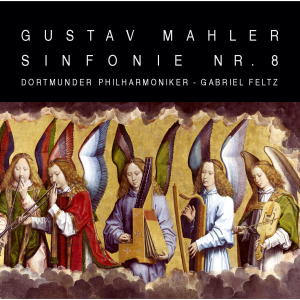

I've not had the opportunity to hear all the recordings of the Gustav Mahler symphonies led by conductor Gabriel Feltz, but the ones I have heard I found to be quite impressive. Here are previous reviews of Symphony No. 1 and Symphony No. 2. There's a natural expansive sweep to his overview of the music. A quality that squares with Mahler's grand gestures very well, especially in a towering work like the Symphony No. 8 in E-flat major 'Symphony of a Thousand'.
Including Gustav Mahler himself at the podium, the September 12th 1910 premiere of this symphony numbered 1008 participants on stage. Therefore earning the honorific moniker 'Symphony of a Thousand'. But as Gabriel Feltz points out in the booklet notes, it can't always be that way nor does it need to be: "These performances of Mahler's 8th Symphony on 3rd and 4th of July 2018 were especially successful. This line-up combined the 8 vocal soloists, 123 men and women in the orchestra, 44 children of the Chorakademie Dortmund and 126 members from the Philharmonic Choirs of Bratislava and Brno: in the end these concerts included 301 musicians. The flanking position of the choirs in relation to the orchestra, and the fact that large parts of the choirs were facing each other was, in my opinion, a decisive advantage: especially in the first part it gave rise to stereophonic effects, which greatly served the double choir passages of the composition, and the balance of the tremendous conglomerations in the tuttis was, I feel, very satisfactory."
The opening salvo of pipe organ, full choir and orchestra in the Veni, creator spiritus is highly charged and effectively sets the pace and spirit of the whole performance. And at the opposite end of the sonic spectrum, the Poco adagio which launches the second part of this work is just as effective in its hushed sense of trepidation at the coming exaltation. All of the soloists enact and perform their individual parts with conviction and can, during this "live" performance, be clearly heard even within the loudest orchestral and choral passages. And when the combined choral forces of 170 are called upon they unleash a mighty sound that belies their numbers. And lets not forget the immense contrapuntal role the orchestra plays in this symphony, not only supporting the vocal forces but actually harmonizing and complementing them. A crucial factor that Gabriel Feltz never loses sight of.
Over the years I've heard many Mahler enthusiasts say that his Symphony No. 8 was always a stumbling block for them: "too long" or "too much constant singing" or "not structured like his other symphonies" are different complaints they would raise. One thing they shared in common is that they always added that they never could listen to the end. If they only had, they would have realized how magnificently everything comes together in the end, and how Gustav Mahler, even within the boundaries of tonality, had attained harmonic nirvana.
Jean-Yves Duperron - January 2020